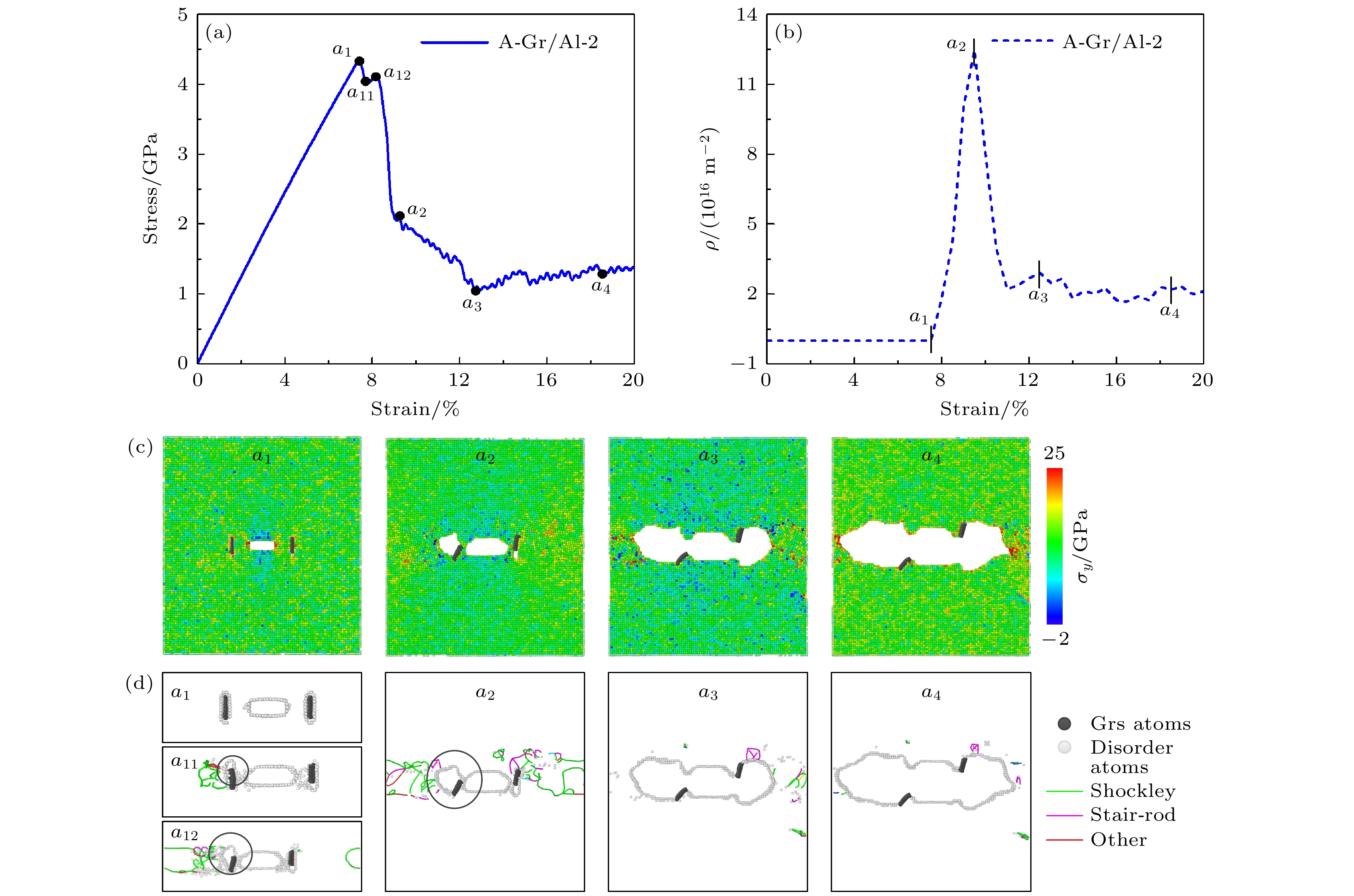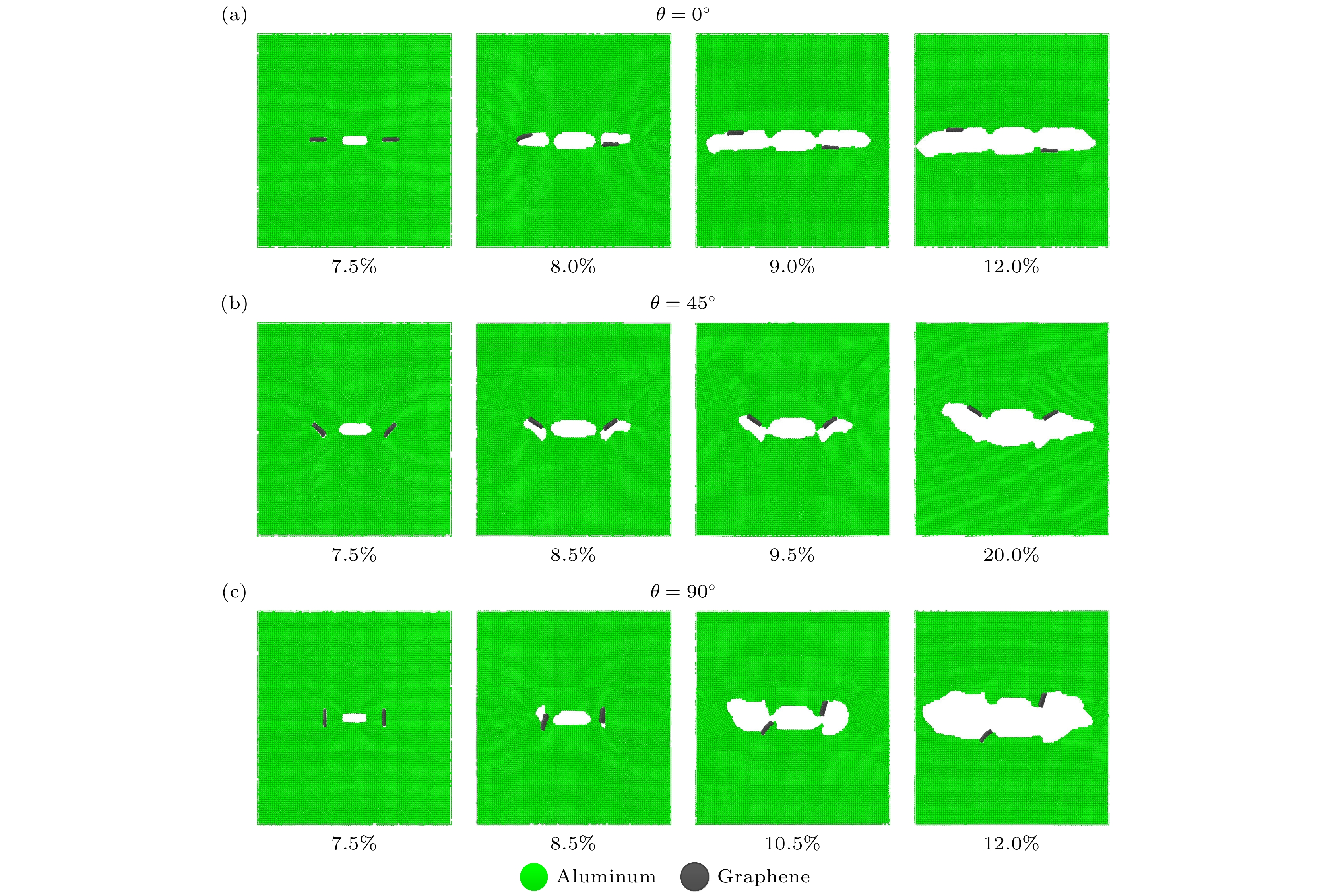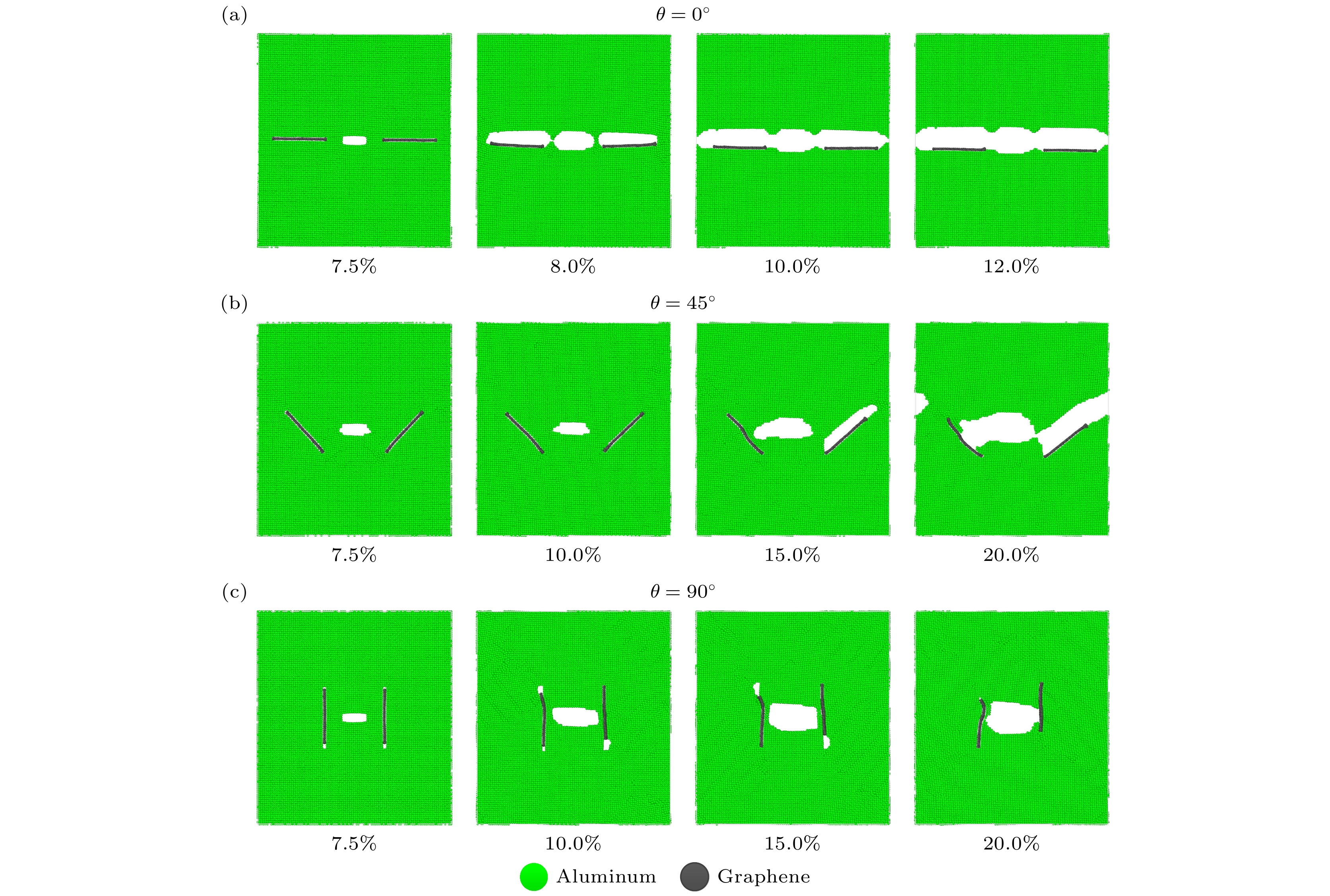-
铝基复合材料由于其质轻高强的特点, 是机械工业和航空航天工程中最重要的材料之一. 而石墨烯因其优异力学性能和高比表面积等特点,被作为金属基复合材料的理想增强相. 然而,目前石墨烯在铝基复合材料中对裂纹扩展影响的机制尚不清晰, 制约了其在铝基复合材料的设计和应用. 本文采用分子动力学模拟方法研究了石墨烯的尺寸和分布对铝基复合材料中裂纹扩展的影响. 研究结果表明, 当石墨烯尺寸 l ≤ 3.35 nm时, 在拉伸过程中产生的亚裂纹促进了裂纹扩展。值得注意的是,这种促进作用随着石墨烯与裂纹的距离增大而减弱. 当石墨烯尺寸 l > 3.35 nm时, 石墨烯阻碍了裂纹的扩展和亚裂纹位错的滑移. 此外, 石墨烯的分布和角度可以有效地改变裂纹扩展路径. 本研究的结果有助于理解石墨烯在其铝基复合材料中的破坏失效的作用, 为设计高性能石墨烯/铝基复合材料提供一定参考依据.Aluminum-based composite material is one of the most important candidate materials in the mechanical industry and aerospace engineering due to its light weight and high strength. Graphene is an ideal reinforcement for composite materials for its excellent mechanical properties. Till-now, the contribution of graphene sheets in the process of crack propagation in composites is not clear. In present work, the effects of graphene size and distribution in graphene/aluminum composites are explored using molecular dynamics simulation methods. It is found that when the length of graphene flake is less than 3.35 nm, the generated sub-cracks in the composite is benefit to the crack propagation. This effect reduces the mechanical properties of composite. When the length of graphene flake is greater than 3.35 nm, graphene sheet impedes the crack propagation and dislocates slip at sub-cracks. In addition, the distribution of graphene flakes angle changes the crack propagation path. Our findings also provide insights into ways to optimize mechanical properties of graphene/aluminum composites.
[1] Singh S, Garg M, Batra N K 2015 Tribol. Trans. 58 758
 Google Scholar
Google Scholar
[2] Hu Z, Tong G, Lin D, Chen C, Guo H, Xu J, Zhou L 2016 Mater. Sci. Technol. 32 930
[3] Jayendra B, Sumanth D, Dinesh G, Rao M V 2020 Mater. Today:Proc. 21 1104
 Google Scholar
Google Scholar
[4] Zhang X, Zhao N, He C 2020 Prog. Mater. Sci. 113 100672
 Google Scholar
Google Scholar
[5] Novoselov K S, Fal'ko V I, Colombo L, Gellert P R, Schwab M G, Kim K 2012 Nature 490 192
 Google Scholar
Google Scholar
[6] Dai Z, Hou Y, Sanchez D A, Wang G, Brennan C J, Zhang Z, Liu L, Lu N 2018 Phys. Rev. Lett. 121 266101
 Google Scholar
Google Scholar
[7] Dai Z, Liu L, Zhang Z 2019 Adv. Mater. 31 1805417
 Google Scholar
Google Scholar
[8] 范冰冰, 郭焕焕, 李稳, 贾瑜, 张锐 2013 物理学报 62 148101
 Google Scholar
Google Scholar
Fan B-B, Guo H-H, Li W, Jia Y, Zhang R 2013 Acta Phys. Sin. 62 148101
 Google Scholar
Google Scholar
[9] Stankovich S, Dikin D A, Dommett G H, Kohlhaas K M, Zimney E J, Stach E A, Piner R D, Nguyen S T, Ruoff R S 2006 Nature 442 282
 Google Scholar
Google Scholar
[10] Zhang P, Ma L, Fan F, Zeng Z, Peng C, Loya P E, Liu Z, Gong Y, Zhang J, Zhang X, Ajayan P M, Zhu T, Lou J 2014 Nat. Commun. 5 3782
 Google Scholar
Google Scholar
[11] Yang Z, Wang D, Lu Z, Hu W 2016 Appl. Phys. Lett. 109 191909
 Google Scholar
Google Scholar
[12] Galashev A Y, Rakhmanova O R 2020 Phys. Lett. A 384 126790
 Google Scholar
Google Scholar
[13] Wegst U G, Bai H, Saiz E, Tomsia A P, Ritchie R O 2015 Nat. Mater. 14 23
 Google Scholar
Google Scholar
[14] Zhang Y, Li X 2017 Nano Lett. 17 6907
 Google Scholar
Google Scholar
[15] Li Z, Guo Q, Li Z, Fan G, Xiong D B, Su Y, Zhang J, Zhang D 2015 Nano Lett. 15 8077
 Google Scholar
Google Scholar
[16] Kim Y, Lee J, Yeom M S, Shin J W, Kim H, Cui Y, Kysar J W, Hone J, Jung Y, Jeon S, Han S M 2013 Nat. Commun. 4 2114
 Google Scholar
Google Scholar
[17] Zhou X, Liu X, Shang J, Yang Q 2020 Mech. Mater. 148 103530
 Google Scholar
Google Scholar
[18] Zhu J Q, Yang Q S, Liu X 2019 Key Eng. Mater. 804 1
 Google Scholar
Google Scholar
[19] Muller S E, Santhapuram R R, Nair A K 2018 Comput. Mater. Sci. 152 341
 Google Scholar
Google Scholar
[20] Su Y, Xu S 2016 Mater. Sci. Eng. , A 678 153
 Google Scholar
Google Scholar
[21] Qiu R Z, Li C C, Fang T H 2017 Phys. Scr. 92 085702
 Google Scholar
Google Scholar
[22] Akbarian S, Dehghani K 2020 Int. J. Fatigue 135 105570
 Google Scholar
Google Scholar
[23] Plimpton S 1995 J. Comput. Phys. 117 1
 Google Scholar
Google Scholar
[24] Wang P, Yang X, Tian X 2015 J. Mater. Res. 30 709
 Google Scholar
Google Scholar
[25] Zhang C, Lu C, Pei L, Li J, Wang R, Tieu K 2019 Carbon 143 125
 Google Scholar
Google Scholar
[26] Daw M S, Baskes M I 1984 Phys. Rev. B 29 6443
 Google Scholar
Google Scholar
[27] Brenner D W, Shenderova O A, Harrison J A, Stuart S J, Ni B, Sinnott S B 2002 J. Phys. Condens. Matter 14 783
 Google Scholar
Google Scholar
[28] Silvestre N, Faria B, Canongia Lopes J N 2014 Compos. Sci. Technol. 90 16
 Google Scholar
Google Scholar
[29] 汉芮岐, 宋海洋, 安敏荣, 李卫卫, 马佳丽 2021 物理学报 70 066201
 Google Scholar
Google Scholar
Han R Q, Song H Y, An M R, Li W W, Ma J L 2021 Acta Phys. Sin. 70 066201
 Google Scholar
Google Scholar
[30] Kumar S 2018 Mater. Chem. Phys. 208 41
 Google Scholar
Google Scholar
[31] Munilla J, Castro M, Carnicero A 2009 Phys. Rev. B 80 024109
 Google Scholar
Google Scholar
[32] Kutana A, Giapis K P 2006 Phys. Rev. Lett. 97 245501
 Google Scholar
Google Scholar
[33] Stukowski A 2010 Modell. Simul. Mater. Sci. Eng. 18 015012
 Google Scholar
Google Scholar
[34] Kelchner C, Plimpton S, Hamilton J 2000 Phys. Rev. B 58 11085
[35] Faken D, Jónsson H 1994 Comput. Mater. Sci. 2 279
 Google Scholar
Google Scholar
[36] Stukowski A, Bulatov V V, Arsenlis A 2012 Modell. Simul. Mater. Sci. Eng. 20 085007
 Google Scholar
Google Scholar
[37] Zheng Y G, Zhang H W, Chen Z, Lu C, Mai Y W 2009 Phys. Lett. A 373 570
 Google Scholar
Google Scholar
[38] Rong Y, He H P, Zhang L, Li N, Zhu Y C 2018 Comput. Mater. Sci. 153 48
 Google Scholar
Google Scholar
-
图 3 (a) 纯铝在单轴拉伸过程中的裂纹长度-应变曲线; (b)—(d) 为图3(a)中的A-C点CSP原子结构图 (插图中绿色原子为面心立方结构 (FCC), 红色原子为密排六方结构 (HCP), 白色原子为其他结构)
Fig. 3. Uniaxial tensile process of pure Al: (a) Crack length-strain curve; (b)–(d) CSP morphology at points A-C correspongding to Fig. 3(a). (Atoms in the inset are colored by the CNA. Green atoms represent face-centered cubic structure (FCC), red atoms represent hexagonal closest packed structure (HCP) and white ones have OTHER structures.)
图 4 (a) p-Gr/Al的单轴拉伸过程裂纹长度-应变曲线; (b)—(e) 为图4(a)中的D-G点CSP原子结构图 (插图中绿色为FCC结构, 红色为HCP结构, 白色为OTHER结构, 黑色为C原子)
Fig. 4. (a) Crack length-strain curve of p-Gr/Al under uniaxial tensile; (b)–(e) CSP morphology of p-Gr/Al corresponding to point D-G in Fig. 4(b). (Atoms in the inset are colored by the CNA. Green atoms have an FCC structure, red atoms have an HCP structure, white ones have other structures and black atoms are C atoms.)
图 5 (a) 不同长度石墨烯Gr/Al复合材料的裂纹长度-应变曲线; (b) Gr/Al 复合材料的裂纹比随石墨烯嵌入长度的变化 (插图中A-Gr/Al和B-Gr/Al分别为A-Gr/Al-2和B-Gr/Al-2模型在20%时原子结构图)
Fig. 5. (a) Crack length-strain curves of Gr/Al composites with different Gr length; (b) relationship between the crack ratio of Gr/Al composites with different length of graphene (In the inset, A-Gr/Al and B-Gr/Al are atomic structure diagrams of A-Gr/Al-2 and B-Gr/Al-2 models at 20%, respectively).
图 9 (a) B-Gr/Al-1复合材料在δ为1.72—4.96 nm范围内的裂纹长度-应变曲线; (b) δ为3.34 nm的B-Gr/Al-1复合材料位错密度的演化; (c), (d) 对应的d2和d3原子结构图
Fig. 9. (a) Crack propagation in the δ range of 1.72—4.96 nm for B-Gr/Al-1; (b) dislocation density evolution in the δ = 3.34 nm for B-Gr/Al-1 composite; (c), (d) corresponding to d2 and d3 atomic structure.
表 1 不同模型的参数, 包括石墨烯长度 (l ) 和石墨烯与裂纹的相对距离 (δ)
Table 1. Parameters of different models including graphene length (l ) and the distance between graphene and crack (δ).
模型名称 l/nm δ/nm 模型名称 l/nm δ/nm Pure Al 0 0 B-Gr/Al-2 5.43 1.72 A-Gr/Al-1 0.97 1.72 B-Gr/Al-3 7.53 1.72 A-Gr/Al-2 1.49 1.72—4.96 B-Gr/Al-4 9.92 1.72 A-Gr/Al-3 2.64 1.72 B-Gr/Al-5 15.22 1.72 A-Gr/Al-4 3.35 1.72 p-Gr/Al 20.25 1.72 B-Gr/Al-1 4.18 1.72—4.96 -
[1] Singh S, Garg M, Batra N K 2015 Tribol. Trans. 58 758
 Google Scholar
Google Scholar
[2] Hu Z, Tong G, Lin D, Chen C, Guo H, Xu J, Zhou L 2016 Mater. Sci. Technol. 32 930
[3] Jayendra B, Sumanth D, Dinesh G, Rao M V 2020 Mater. Today:Proc. 21 1104
 Google Scholar
Google Scholar
[4] Zhang X, Zhao N, He C 2020 Prog. Mater. Sci. 113 100672
 Google Scholar
Google Scholar
[5] Novoselov K S, Fal'ko V I, Colombo L, Gellert P R, Schwab M G, Kim K 2012 Nature 490 192
 Google Scholar
Google Scholar
[6] Dai Z, Hou Y, Sanchez D A, Wang G, Brennan C J, Zhang Z, Liu L, Lu N 2018 Phys. Rev. Lett. 121 266101
 Google Scholar
Google Scholar
[7] Dai Z, Liu L, Zhang Z 2019 Adv. Mater. 31 1805417
 Google Scholar
Google Scholar
[8] 范冰冰, 郭焕焕, 李稳, 贾瑜, 张锐 2013 物理学报 62 148101
 Google Scholar
Google Scholar
Fan B-B, Guo H-H, Li W, Jia Y, Zhang R 2013 Acta Phys. Sin. 62 148101
 Google Scholar
Google Scholar
[9] Stankovich S, Dikin D A, Dommett G H, Kohlhaas K M, Zimney E J, Stach E A, Piner R D, Nguyen S T, Ruoff R S 2006 Nature 442 282
 Google Scholar
Google Scholar
[10] Zhang P, Ma L, Fan F, Zeng Z, Peng C, Loya P E, Liu Z, Gong Y, Zhang J, Zhang X, Ajayan P M, Zhu T, Lou J 2014 Nat. Commun. 5 3782
 Google Scholar
Google Scholar
[11] Yang Z, Wang D, Lu Z, Hu W 2016 Appl. Phys. Lett. 109 191909
 Google Scholar
Google Scholar
[12] Galashev A Y, Rakhmanova O R 2020 Phys. Lett. A 384 126790
 Google Scholar
Google Scholar
[13] Wegst U G, Bai H, Saiz E, Tomsia A P, Ritchie R O 2015 Nat. Mater. 14 23
 Google Scholar
Google Scholar
[14] Zhang Y, Li X 2017 Nano Lett. 17 6907
 Google Scholar
Google Scholar
[15] Li Z, Guo Q, Li Z, Fan G, Xiong D B, Su Y, Zhang J, Zhang D 2015 Nano Lett. 15 8077
 Google Scholar
Google Scholar
[16] Kim Y, Lee J, Yeom M S, Shin J W, Kim H, Cui Y, Kysar J W, Hone J, Jung Y, Jeon S, Han S M 2013 Nat. Commun. 4 2114
 Google Scholar
Google Scholar
[17] Zhou X, Liu X, Shang J, Yang Q 2020 Mech. Mater. 148 103530
 Google Scholar
Google Scholar
[18] Zhu J Q, Yang Q S, Liu X 2019 Key Eng. Mater. 804 1
 Google Scholar
Google Scholar
[19] Muller S E, Santhapuram R R, Nair A K 2018 Comput. Mater. Sci. 152 341
 Google Scholar
Google Scholar
[20] Su Y, Xu S 2016 Mater. Sci. Eng. , A 678 153
 Google Scholar
Google Scholar
[21] Qiu R Z, Li C C, Fang T H 2017 Phys. Scr. 92 085702
 Google Scholar
Google Scholar
[22] Akbarian S, Dehghani K 2020 Int. J. Fatigue 135 105570
 Google Scholar
Google Scholar
[23] Plimpton S 1995 J. Comput. Phys. 117 1
 Google Scholar
Google Scholar
[24] Wang P, Yang X, Tian X 2015 J. Mater. Res. 30 709
 Google Scholar
Google Scholar
[25] Zhang C, Lu C, Pei L, Li J, Wang R, Tieu K 2019 Carbon 143 125
 Google Scholar
Google Scholar
[26] Daw M S, Baskes M I 1984 Phys. Rev. B 29 6443
 Google Scholar
Google Scholar
[27] Brenner D W, Shenderova O A, Harrison J A, Stuart S J, Ni B, Sinnott S B 2002 J. Phys. Condens. Matter 14 783
 Google Scholar
Google Scholar
[28] Silvestre N, Faria B, Canongia Lopes J N 2014 Compos. Sci. Technol. 90 16
 Google Scholar
Google Scholar
[29] 汉芮岐, 宋海洋, 安敏荣, 李卫卫, 马佳丽 2021 物理学报 70 066201
 Google Scholar
Google Scholar
Han R Q, Song H Y, An M R, Li W W, Ma J L 2021 Acta Phys. Sin. 70 066201
 Google Scholar
Google Scholar
[30] Kumar S 2018 Mater. Chem. Phys. 208 41
 Google Scholar
Google Scholar
[31] Munilla J, Castro M, Carnicero A 2009 Phys. Rev. B 80 024109
 Google Scholar
Google Scholar
[32] Kutana A, Giapis K P 2006 Phys. Rev. Lett. 97 245501
 Google Scholar
Google Scholar
[33] Stukowski A 2010 Modell. Simul. Mater. Sci. Eng. 18 015012
 Google Scholar
Google Scholar
[34] Kelchner C, Plimpton S, Hamilton J 2000 Phys. Rev. B 58 11085
[35] Faken D, Jónsson H 1994 Comput. Mater. Sci. 2 279
 Google Scholar
Google Scholar
[36] Stukowski A, Bulatov V V, Arsenlis A 2012 Modell. Simul. Mater. Sci. Eng. 20 085007
 Google Scholar
Google Scholar
[37] Zheng Y G, Zhang H W, Chen Z, Lu C, Mai Y W 2009 Phys. Lett. A 373 570
 Google Scholar
Google Scholar
[38] Rong Y, He H P, Zhang L, Li N, Zhu Y C 2018 Comput. Mater. Sci. 153 48
 Google Scholar
Google Scholar
计量
- 文章访问数: 9696
- PDF下载量: 137
- 被引次数: 0














 下载:
下载:











